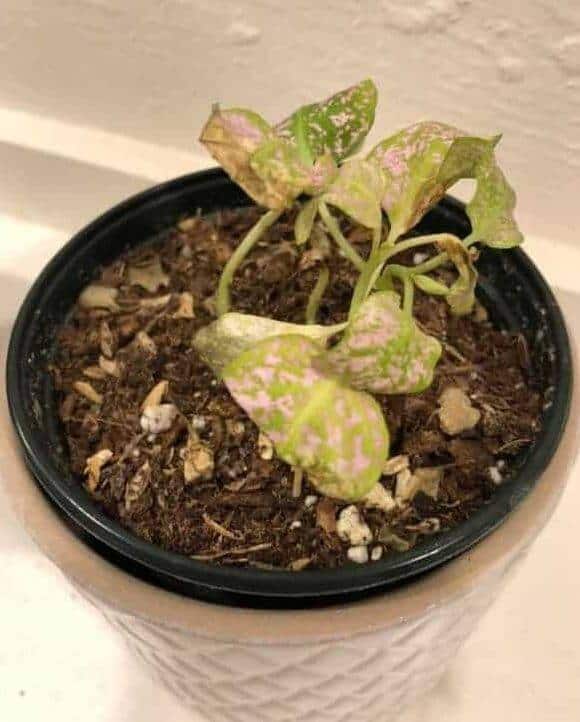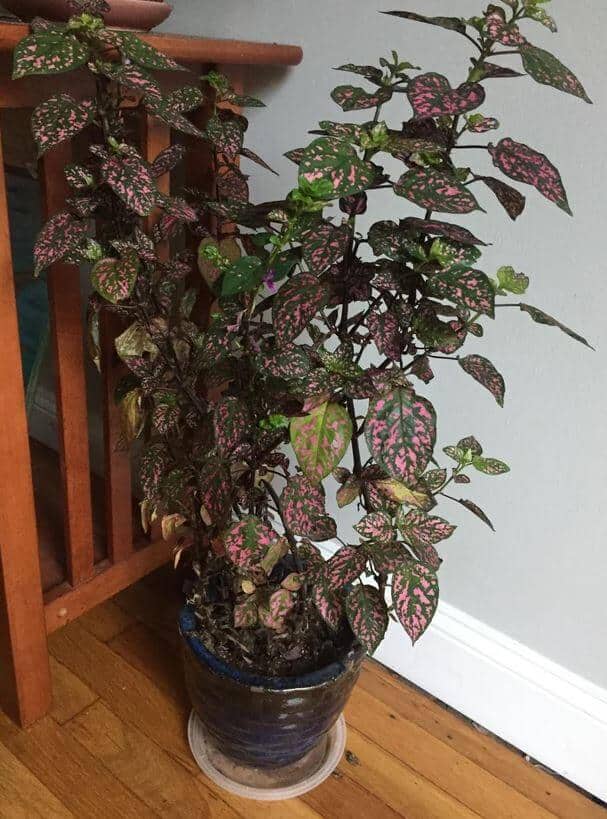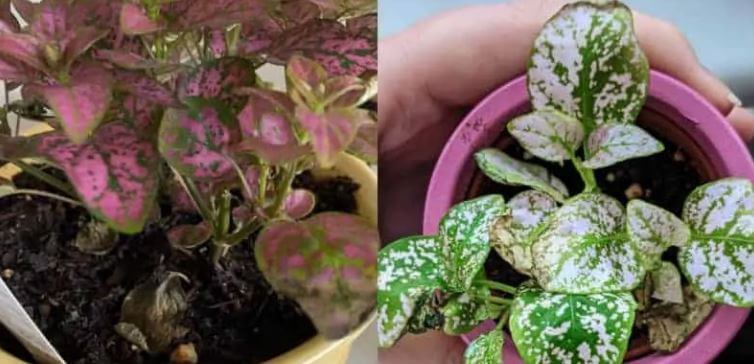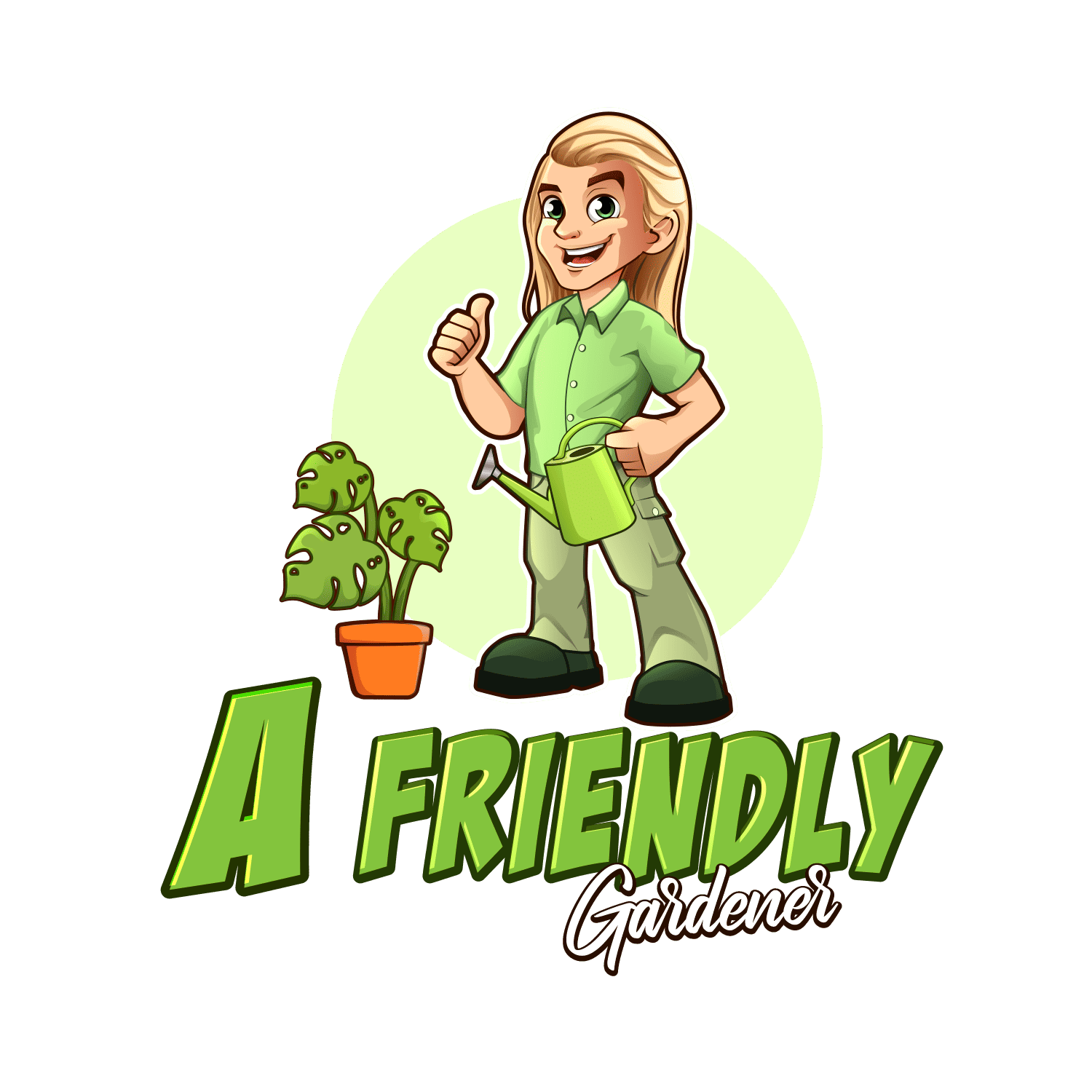Last Updated on January 5, 2023 by a Friendly Gardener
Madagascar native the Polka Dot plant, is a colorful favorite in indoor home gardens. Botanically known as the Hypoestes Phyllostachya is an herbaceous perennial belonging to the Acanthaceae family. This ornamental plant with its splash of color and delightful patterns brightens every décor. So, when foliage begins to suffer, and your plant looks bad, alarm bells go off. Is my polka dot dying?
While an easy-to-care-for plant, the Polka Dot plant is, like any houseplant, susceptible to a variety of problems from environmental conditions to watering, lighting, disease, pests, and much more. If you fear your Polka Dot plant is dying, read on, and with the right care in most cases, your plant will be on the mend.
Why Are My Polka Dot Plant Leaves Turning Crispy and Brown?

Polka dot plants generally feature a red, pink, or white flush on foliage. They should not have brown edges or spots. Brown leaf tips are also a problem as are brown watery lesions on leaves
Polka Dot Plant crispy leaves that are dry and brittle are a red flag that something is wrong. Reasons for leaves becoming crispy include excessive dehydration, extreme heat, water quality, excessive feeding, or a lack of humidity among the most common.
Underwatering

When cultivating a Polka Dot plant, never permit your plant’s soil bed to dry out completely. Underwatering is a problem and these plants are particularly at risk during the summer months and warm weather. Evaporation will cause the soil bed to lose some of its moisture. Hot weather will also cause increased transpiration adding to an increased loss of moisture. If the plant is unable to absorb sufficient water, the foliage will crisp.
To resolve this, consider deep soaking your plant thoroughly and allowing excess water to drain out.
Set your plant in the sink or tub and fill it with approximately three inches of tepid water. Allow your plant to absorb water from the drainage holes in the container for about 45 minutes. The soil bed should be uniformly damp. Let the container drain completely.
Remember that in warm weather, you may need to water more frequently. Maintain irrigation consistency. Water when the top inch of the soil bed is dry.
Overwatering
Although it is rare, leaves can crisp when the plant is overwatered. This can happen with soggy soil where the water deprives plant root systems of oxygen. Repot your plant in fresh soil and wait before watering your plant anew.
Extreme Heat

If your sun is exposed to too much direct soil or hot drafts, leaves may be crisp. Keep your plant away from heating units, fireplaces, and vents, and avoid placing your plant in a window with too much direct sunlight. Ideal temperatures should be between 70° and 75° F.
Water Quality
Tap water may include chemicals like fluoride, chlorine, or minerals that are toxic to your plant. Use collected rainwater or distilled water for your plant. You can also use a filtration system. Also, remember that Polka Dot plants are highly sensitive to hot and cold water, so always use tepid or room-temperature water.
Excessive Fertilization
Overfeeding your plant may cause leaves to develop brown tips and spots and then become crispy. This indicates excessive salt buildup in the soil bed. Interrupt fertilizing and repot your plant with fresh soil.
Lack of Humidity
If your home is centrally heated, low environmental humidity may cause crispy edges. Polka Dot plants need at least 50% humidity while some cultivars may need 60%. Methods for increasing humidity include:
- Placing your plant in a kitchen or bathroom
- Placing a pebble tray underneath your plant
- Grouping plants together to create a microclimate
- Using a space humidifier
Fungal Infections and Disease
Fungal infections like anthracnose, downy mildew, or powdery mildew can cause foliage to brown and turn crispy. Irregular lesions on leaves are generally the first indication that your plant is ill. They will expand and spread, eventually drying out.
If you suspect a fungal disease, trim off all infected foliage, and use a fungicide to treat your plant. Neem oil is a natural organic fungicide. For severely infected plants, dispose of the plant.
Root rot is due to overwatering. Stems and leaves will turn brown and mushy and emit an odor. If your plant has root rot, you will need to repot the plant. Remove the plant and trim away infected roots and plant parts. Repot your plant in fresh soil and wait a week before watering anew.
Pest Infestations
Like all houseplants, the Polka Dot is susceptible to infestations by spider mites, scale, aphids, whiteflies, and mealybugs. Leaves will fade, discolor, and develop holes. In the case of spider mites, you may find webbing where the leaves meet the stems.
Mealybugs and scale can be removed manually. Other pests can be removed with a jet spray of water. After, treat the plant with insecticidal soap or with an organic pesticide like Neem oil.
Why Is My Polka Dot Plant Wilting?

Many of the same causes of leaf drop, and brown or crispy leaves will cause wilting and it may be the first indication that your plant is suffering. The Polka Dot plant may wilt because of extreme temperatures, insufficient humidity, or a watering problem. While wilting commonly happens for a lack of water, overwatering can also be at the root of this symptom. Water quality, too much sunlight exposure, too much fertilizer, or even an undersized root ball can stimulate wilting.
When a Polka Dot plant goes into shock, wilting may be the immediate reaction. Polka Dots like bright indirect light, so overexposure to sunlight can send this plant into temporary shock. Repotting can do the same. Replanting your Polka Dot can cause systemic shock, so expect that your plant may need some time to acclimatize to its new container and soil bed.
An unusual problem that can cause wilting is when the root ball of the plant is too small in dimension when compared to plant foliage. In this case, the plant will dedicate more of its energy to developing foliage than to the growth of the root ball. This results in a growth imbalance. To aid your plant, prune foliage and pinch off new leaf growth so that your plant channels energy to root system development.
Why Are My Polka Dot Plant Leaves Falling Off?
A Polka Dot plant that experiences leaf drop can be worrying. Some leaf drop is normal for any plant, especially as a result of the natural aging of the plant. Nonetheless, there are several external factors that can provoke leaf drop.
Overwatering is a typical cause of leaf drop. When roots are left to sit in soggy soil, they will become mushy and soft meaning that they can no longer send nutrients as well as moisture and oxygen throughout the plant. The plant will spontaneously shed some foliage to save energy resources. Underwatering can also cause leaf drop. If leaves appear crispy and dry when they drop, insufficient water may be the culprit.
When natural shedding due to aging is the reason there is nothing to be alarmed about. Healthy plants will generally shed their oldest leaves so that energy can be diverted to new growth. When your plant occasionally loses one or two leaves, this is to be expected. If your plant is losing a greater number of leaves at shorter intervals, you may need to consider one of the other reasons and find a solution.
Leaf drop should be taken seriously as if it happens for any reason other than natural aging, the condition causing the problem can be fatal if left unattended.
Other Problems
Other problems that can appear with a Polka Dot plant include yellowing leaves which usually indicate overwatering. If your plant becomes rootbound it may also begin to suffer and will need to be repotted in a new container that is a size or two larger.
With excessive exposure to direct sunlight, foliage risks scorching. Exaggerated lighting may cause spots and variegation to fade. These plants need bright light to maintain the vibrancy of their color, but light must be rigorously indirect.
Is My Polka Dot Plant Dying?

The reasons that your Polka Dot plant may be wilting, withering, turning brown and crispy, or dropping foliage can be due to improper environmental or cultivating conditions, Incorrect watering is at the top of the list, but bad lighting, pest infestations, poor soil quality, infections, and diseases can all account for worrying symptoms and when left untreated can be fatal for your plant.

